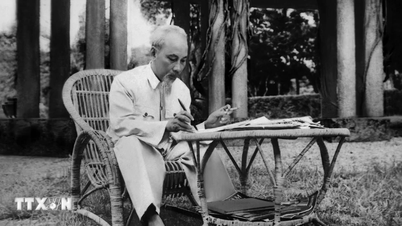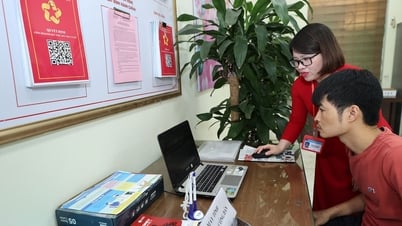After the incident in which five people in Ho Chi Minh City were poisoned by cleaning chemicals to the point of being life-threatening, experts warned people to be careful when exposed to chemicals.
According to information from the Ho Chi Minh City Department of Health , Binh Chanh District Hospital has just received 5 cases of suspected poisoning from the chemical PAC (Poly Aluminum Chloride).
It is known that PAC is a type of aluminum alum, existing in high molecular form (polymer). This chemical is also known as a precipitant or coagulant, which can increase the clarity of water, prolong the filtration cycle as well as improve the quality of water after filtration. PAC is a sequestering agent, significantly improving the properties of polymers in water.
 |
| Illustration photo. |
Previously, also regarding chemical poisoning, information from the Department of Intensive Care - Anti-Poison, Phu Tho General Hospital said that the facility had just received 2 patients in deep coma suspected of gas poisoning transferred from the district medical center.
According to medical experts, in daily life, we often use chemicals for daily life and production including: dishwashing liquid, laundry soap, detergents, bath soap, pesticides, rat poison...
If first aid for chemical poisoning is not given promptly, the victim of chemical poisoning will become unconscious, agitated, have convulsions, stop breathing, and even die.
Chemical poisoning is the condition of swallowing, contacting or injecting drugs, chemicals, or inhaling toxic gases. With detergents, many people are poisoned by accidentally drinking them or by skin contact.
There are many types of chemicals, each of which penetrates and affects health differently. Depending on the way of chemical exposure, symptoms are divided into several groups including:
Respiratory poisoning: Chemicals can cause damage, burns to the respiratory tract or damage to lung parenchyma, causing respiratory spasms, wheezing. If the respiratory tract fails, the patient will turn cyanotic, become comatose, stop breathing, and die.
Chemical poisoning through the skin: Chemicals spilled on the skin cause burns (red skin, blisters, ulcers, etc.).
Chemical poisoning through the digestive tract: In case of accidentally drinking chemicals, symptoms include: Discomfort, dizziness, abdominal pain, repeated vomiting, abdominal pain.
Chemical poisoning of the nervous system: Chemicals affect the nervous system causing dizziness, headache, convulsions, and coma. If not treated promptly, it can lead to cardiovascular collapse and death.
Chemical poisoning affects the circulatory system causing symptoms such as: low blood pressure, rapid heartbeat.
Principles for handling when discovering a person with poisoning:
Step 1: Observe the surroundings, ensure safety, and get closer to find the cause.
Step 2: Quickly take the patient to a safe place.
Step 3: Observe and assess the patient's condition.
Step 4: Perform simple first aid if you have knowledge of first aid for chemical poisoning.
Step 5: If the victim is conscious, collect information, take pictures or bring any toxic chemicals.
Step 6: Call an ambulance and take the patient to the nearest hospital.
Based on the condition and route of exposure to the chemical, perform appropriate first aid. For example, with respiratory poisoning: Quickly move the patient away from the area with toxic gas or chemicals to a well-ventilated area. Perform artificial respiration if the patient turns blue, has stopped breathing and circulation.
Skin poisoning: Quickly take the patient to a clean water source, wash the substance on the skin with soap or a skin-safe cleaning solution. If the poison splashes into the eyes, gently rinse the eyes with clean water.
In case of poisoning through the digestive tract, quickly take the patient to the nearest medical facility for timely emergency treatment.
In all cases of chemical poisoning, after the initial first aid, the patient should be taken to a reputable medical facility near home for timely treatment. Avoid prolonging the time, causing serious complications, endangering life.
At the hospital, the patient is examined and assessed. Family members should bring the chemical that the patient drank or inhaled so that the doctor can accurately identify the substance causing the poisoning. This will help the doctor use the correct antidote to the chemical. The doctor will treat the cause of the poisoning.
When detecting a person with chemical poisoning, it is necessary to pay attention to information such as the name of the chemical: Usually clearly stated on the packaging, bag or bottle. It is necessary to remember, take a photo or bring it to the hospital. This helps the doctor to identify the chemical more quickly and use specific treatment drugs promptly.
Note the amount and time of exposure to the chemical. Note the initial symptoms and signs of poisoning. If the chemical gets into your eyes, do not use any eye drops on your own. Only wash your eyes with clean water. If the patient accidentally drinks a chemical, do not use emetic syrup or any other emetic.
In case of suspected child swallowing of watch battery, go to hospital to have the battery checked and removed. Batteries left in the human body for a long time are dangerous to health.
Chemicals play an essential role in daily life, but to ensure safety, people need to know how to preserve and use chemicals. The types of chemicals widely used today include soaps, shampoos, hand washes, etc.
Cleaning chemicals such as: Soap, fabric softener, bleach, drain cleaner, floor cleaner, dishwashing liquid, glass cleaner, etc.
Cleaning chemicals containing organic solvents: Turpentine oil, turpentine, paint, lacquer, adhesives, dyes, pharmaceuticals…
Disinfectant and deodorizing products: Hydrogen peroxide, potassium permanganate, alcohol, etc. Gasoline-like substances, paint solvents.
Chemicals to repel and kill insects: Mosquito and fly spray, rat poison, ant poison, etc. Chemicals used in agriculture : Pesticides, herbicides, chemical fertilizers, etc.
In cases where contact with pesticides, herbicides, etc. is required, protective gear such as masks, screens, and gloves must be used to avoid direct contact with chemicals. Store chemicals in a high place, out of reach of children, and label the bottle. In case of poisoning, remain calm and provide first aid and take to the nearest medical facility.

























![[Photo] Central Propaganda and Mass Mobilization Department meets with exemplary journalists](https://vphoto.vietnam.vn/thumb/1200x675/vietnam/resource/IMAGE/2025/6/21/9509840458074c03a5831541450d39f8)






















![[Maritime News] Wan Hai Lines invests $150 million to buy 48,000 containers](https://vphoto.vietnam.vn/thumb/402x226/vietnam/resource/IMAGE/2025/6/20/c945a62aff624b4bb5c25e67e9bcc1cb)








































Comment (0)